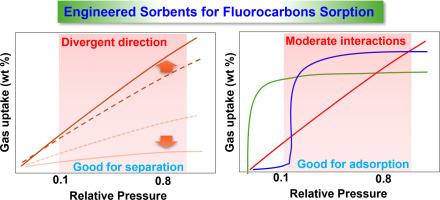Engineered nanoporous sorbents for gaseous fluorocarbons related adsorption applications
引用次数: 0
Abstract
The utilization or emission of fluorocarbons in varied industries, including fine chemicals development, nonferrous metals smelting, electronics/semiconductors fabrication, and space heating/cooling, is continuously increasing year after year due to society advancement and population expansion, but at the prices of chemicals waste and irreversible environmental issues. Thus, the development of engineered solid sorbents will necessitate the capture, separation, and recycling of fluorocarbons in each scenario. This review initially discusses the sources and techniques required for various fluorocarbons used or emitted in existing industries, followed by a brief introduction to the importances of sorption media. The impacts of sorbents used in fluorocarbon sorption-related applications are reviewed to emphasize the importance of engineered nanoporous sorbents with specific textural/chemical properties to improve sorption-related performance. Furthermore, engineered strategies for sorbent design based on continuous pore-filling mechanisms, including sorbent-fluorocarbons interactions by controlling the strength of acid-base pairs and fluorocarbon-fluorocarbon interactions by tuning pore size/dimension/shape/morphology, are outlined. In addition, systemic experimental and computational characterizations provide insights into structure-performance correlations and corresponding sorption mechanisms. Next, we exemplified perfluorocarbons and refrigerants as typical fluorocarbons to further illustrate the roles of engineered nanoporous sorbents in fluorocarbon sorption performance. Finally, we emphasize the future challenges and opportunities for fluorinated gas purification and reuse with the “Mechanisms—Data” dual-driven conception for engineered nanoporous sorbent development.

工程纳米多孔吸附剂的气体氟碳相关的吸附应用
随着社会的进步和人口的增长,精细化学品开发、有色金属冶炼、电子/半导体制造、空间加热/制冷等各行业对氟碳化合物的利用或排放逐年持续增加,但代价是化学废物和不可逆转的环境问题。因此,工程固体吸附剂的发展将需要在每种情况下捕获、分离和回收氟碳化合物。本综述首先讨论了现有工业中使用或排放的各种氟碳化合物的来源和所需的技术,然后简要介绍了吸附介质的重要性。综述了氟碳吸附相关应用中使用的吸附剂的影响,强调了具有特定结构/化学性质的工程纳米孔吸附剂对改善吸附相关性能的重要性。此外,还概述了基于连续孔隙填充机制的吸附剂设计的工程策略,包括通过控制酸碱对的强度来控制吸附剂与碳氟化合物的相互作用,以及通过调整孔隙大小/尺寸/形状/形态来调节碳氟化合物与碳氟化合物的相互作用。此外,系统的实验和计算表征为结构-性能相关性和相应的吸附机制提供了见解。接下来,我们以全氟碳化合物和制冷剂为典型的氟碳化合物为例,进一步说明工程纳米孔吸附剂对氟碳吸附性能的作用。最后,我们以“机制-数据”双重驱动的概念为工程纳米孔吸附剂的开发强调了氟化气体净化和再利用的未来挑战和机遇。
本文章由计算机程序翻译,如有差异,请以英文原文为准。
求助全文
约1分钟内获得全文
求助全文

 求助内容:
求助内容: 应助结果提醒方式:
应助结果提醒方式:


